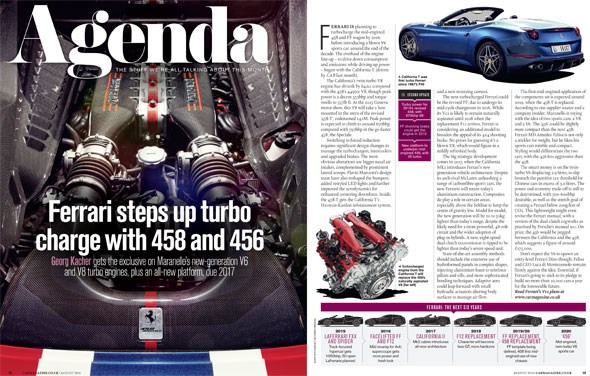Ferrari might be preparing to turbocharge its V8 engines – like on 2015’s updated, blown 458 Italia – but Maranello’s V12s will remain naturally aspirated, CAR can reveal.
Mid-term at least, the V12s will remain members of the free-breathing fraternity and a special scoop dossier in the new August 2014 issue of CAR magazine out this week is packed with details of Ferrari’s new engines.
The 6.3-litre unit fitted to LaFerrari where it develops 800bhp and 516lb ft demonstrates that there is still plenty of life left in the high-revving normally-aspirated big-block unit.
The future of Ferrari V12s: no turbos and more power
The FF will undergo its mid-cycle facelift in 2016, when the output of the charismatic 48-valver will likely to climb from 660 to close to 700bhp, CAR understands.
Also in 2016, we should see an improved F12 Berlinetta which does not really need fresh make-up or more power – but is set to get both. Again, the V12 remains a turbo-free zone, and there is no hybrid version forecast either.
But electric hybrids are coming
Electrification is an integral part of the all-new Ferrari architectures which are due to come on stream from 2017 (front-engined cars) and 2019 (mid-engined cars), respectively.
It is at this point still unclear how exactly Ferrari is going to address the critical e-mobility issues. From a 48-volt circuit to plug-in hybrids, anything seems possible – and the learnings from LaFerrari will surely prove useful here.
Not just more power; lighter weight too
Ferrari has taken a judgment that its top-end cars need to remain faithful to the V12 format with which the brand is so closely associated. Its wealthy clients demand it and Maranello is confident it can achieve some of the benefits of turbocharging – namely better performance and improved economy – through other means.
Ferrari is already at the cutting edge of lightweight tech and the next generation of supercars will stick with aluminium, CAR understands. Carbonfibre does play a role in certain areas, and the new modular structures are going to be between 20 and 50 kilos lighter, depending on the model concerned.
To keep the centre of gravity as low to the ground as possible, composites will be used primarily above the beltline. Efficiency gains are also to result from the new eight-speed gearboxes in the works, the extensive use of hydroformed extrusion panels, injected aluminium foam used to reinforce pillars and sills, and more sophisticated bonding techniques.
Carbonfibre roofs are a distinct possibility, too, as are composite hang-on panels and integrated lightweight air deflection elements masterminded by small hydraulic actuators.
See more of CAR magazine’s Ferrari engine scoop in the new August 2014 issue on sale this week. Click here for a sneak preview.
